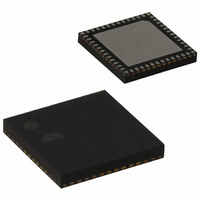EM357-RTR Ember, EM357-RTR Datasheet - Page 37

EM357-RTR
Manufacturer Part Number
EM357-RTR
Description
IC RF TXRX ZIGBEE 192KB 48QFN
Manufacturer
Ember
Specifications of EM357-RTR
Frequency
2.4GHz
Data Rate - Maximum
250kbps
Modulation Or Protocol
802.15.4 Zigbee
Applications
General Purpose
Power - Output
5dBm
Sensitivity
-100dBm
Voltage - Supply
2.1 V ~ 3.6 V
Current - Receiving
26mA
Current - Transmitting
31mA
Data Interface
PCB, Surface Mount
Memory Size
192kB Flash, 12kB RAM
Antenna Connector
PCB, Surface Mount
Operating Temperature
-40°C ~ 85°C
Package / Case
48-QFN
Lead Free Status / RoHS Status
Lead free / RoHS Compliant
Other names
636-1011-2
Available stocks
Company
Part Number
Manufacturer
Quantity
Price
Company:
Part Number:
EM357-RTR
Manufacturer:
SILICON
Quantity:
3 000
Part Number:
EM357-RTR
Manufacturer:
SILICON
Quantity:
20 000
EM351 / EM357
5.2.1.5 Simulated EEPROM
Ember software reserves 8 kB of the main flash block as a simulated EEPROM storage area for stack and
customer tokens. The simulated EEPROM storage area implements a wear-leveling algorithm to extend the
number of simulated EEPROM write cycles beyond the physical limit of 20,000 write cycles for which each
flash cell is qualified.
5.2.2
RAM
5.2.2.1 RAM Overview
The EM35x has 12 kB of static RAM on-chip. The start of RAM is mapped to address 0x20000000. Although the
TM
ARM
®
Cortex
-M3 allows bit band accesses to this address region, the standard MPU configuration does not
permit use of the bit-band feature.
TM
The RAM is physically connected to the AHB System bus and is therefore accessible to both the ARM
®
Cortex
-
M3 microprocessor and the debugger. The RAM can be accessed for both instruction and data fetches as bytes,
half words, or words. The standard MPU configuration does not permit execution from the RAM, but for special
purposes the MPU may be disabled. To the bus, the RAM appears as 32-bit wide memory and in most situations
has zero wait state read or write access. In the higher CPU clock mode the RAM requires two wait states. This
is handled by hardware transparent to the user application with no configuration required.
5.2.2.2 Direct Memory Access (DMA) to RAM
Several of the peripherals are equipped with DMA controllers allowing them to transfer data into and out of
RAM autonomously. This applies to the radio (802.15.4-2003 MAC), general purpose ADC, and both serial
controllers. In the case of the serial controllers, the DMA is full duplex so that a read and a write to RAM may
be requested at the same time. Thus there are six DMA channels in total. See Chapter 8, Section 8.7 and
Chapter 10, Section 10.1.4 for a description of how to configure the serial controllers and ADC for DMA
operation. The DMA channels do not use AHB system bus bandwidth as they access the RAM directly.
The EM35x integrates a DMA arbiter that ensures fair access to the microprocessor as well as the peripherals
through a fixed priority scheme appropriate to the memory bandwidth requirements of each master. The
priority scheme is as follows, with the top peripheral being the highest priority:
1. General Purpose ADC
2. Serial Controller 2 Receive
3. Serial Controller 2 Transmit
4. MAC
5. Serial Controller 1 Receive
6. Serial Controller 1 Transmit
5.2.2.3 RAM Memory Protection
The EM35x integrates two memory protection mechanisms. The first memory protection mechanism is through
TM
®
the ARM
Cortex
-M3 Memory Protection Unit (MPU) described in the Memory Protection Unit section. The
MPU may be used to protect any area of memory. MPU configuration is normally handled by Ember software.
The second memory protection mechanism is through a fine granularity RAM protection module. This allows
segmentation of the RAM into 32-byte blocks where any block can be marked as write protected. An attempt
to write to a protected RAM block using a user mode write results in a bus error being signaled on the AHB
System bus. A privileged mode write is allowed at any time and reads are allowed in either mode. The main
purpose of this fine granularity RAM protection module is to notify the software of erroneous writes to system
areas of memory. RAM protection is configured using a group of registers that provide a bit map. Each bit in
the map represents a 32-byte block of RAM. When the bit is set the block is write-protected.
The fine granularity RAM memory protection mechanism is also available to the peripheral DMA controllers. A
register bit enables protection from DMA writes to protected memory. If a DMA write is made to a protected
location in RAM, a management interrupt is generated. At the same time the faulting address and the
5-7
120-035X-000G
Final



















